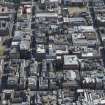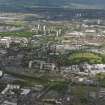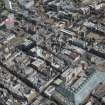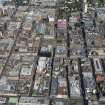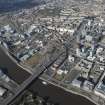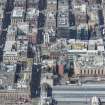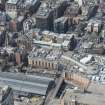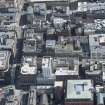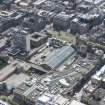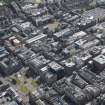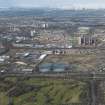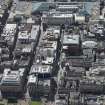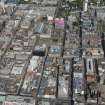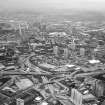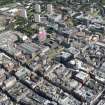Glasgow, General
Burgh (Medieval), Town (Period Unassigned)
Site Name Glasgow, General
Classification Burgh (Medieval), Town (Period Unassigned)
Canmore ID 75627
Site Number NS56NE 94
NGR NS 5894 6573
Datum OSGB36 - NGR
Permalink http://canmore.org.uk/site/75627
- Council Glasgow, City Of
- Parish Glasgow (City Of Glasgow)
- Former Region Strathclyde
- Former District City Of Glasgow
- Former County Lanarkshire
NS56NE 94 59 65
King William granted to the bishop of Glasgow in 1175 x 1178 a burgh at Glasgow with a weekly market and all the liberties of a king's burgh. Glasgow was erected a burgh of regality in 1587, and became legally a royal burgh in 1611. (Cf burghs of Anderston, Pollokshaws and Rutherglen, NS56NE 95, NS56SE 91 and NS66SW 69 respectively).
G S Pryde 1965.
Glasgow, Warehouse and Office
Architect: John Honeyman
Glasgow, Bartica Grove
Plans:
Dick Peddie and MacKay, Edinburgh Additions
Bin 7, Bag 2 n/d
NMRS photographs:
Glasgow, Bank of Scotland
see Unidentified Bank of Scotland
Robert and James Adam in Soane Collection/Unidentified
Soane Museum, Robert and Lames Adam.
Glasgow, Black Quarry - unlocated at time of upgrade, 16.5.2000
Photographs: Mitchell Library Bygone, Glasgow no.39 - reproduction of drawing, 1879 of canal bridge, near quarry.
Glasgow, Bell's Quarry - unlocated at time of upgrade, 17.5.2000
Newscuttings Album no.1: Glasgow Evening News.
Cutting no. 104 - Bell's Quarry - painting by Simpson, c.1830.
Glasgow, Balaam's Pass
Newscuttings Album no.1: Glasgow Evening News.
p.185 Balaam's Pass between London Street and Great Hamilton Street (London Rd).
Unlocated at time of upgrade, 17.5.2000
Glasgow, Belhaven Road
GW/1369/28, 1959
Unlocated at time of upgrade, 18.5.2000
Glasgow, Belmont House, Residence of Sir Robert Reid.
Photographs: Mitchell Library, William Graham, Volume I, p.38.
Glasgow, 34 Bread Street.
63 New Earl Street/Bread Street Corner block, 1868 Post Office Directory - View of messrs Croggan's p/c in box - unable to locate in PO Directory.
GWD/139/1 Missing 13.1.1993
Glasgow, Abbatoirs.
Architect: Clarke and Bell
2 prints - missing 13.8.1993
Glasgow, Auxillary Airforce Headquarters.
Architect: Launcelot Ross
Precise location uncertain at time of upgrade, 22.5.2000
Glasgow, Kelvinside, Amalfi House.
View of conservatory erected at Amalfi House, Kelvinside, Glasgow.
Copied from 'MacKenzie and Moncur's Catalogue of Horticultural Buildings, 1907' p.96
Precise location of Amalfi House uncertain at time of upgrade, 23.5.2000
Glasgow, Arcadian Cafe.
Architect: Charles G. Soutar.
Glasgow, Aqueduct Bridge.
Photographs: Mitchell Library, Glasgow in Former Times I - Lithograph by James Anderson, 1835. P.69
EXTERNAL REFERENCE;
Glasgow, Dye House (Meeting).
Sources: Strathclyde Regional Archives.
5.90. Unidentified, No date. (c. 1830).
A back court and surrounding buildings one of which is marked "Metting House formerly Dye House". Signatures of Thomas Lamb, Thomas Lamb, Thomas Way, John Taylor, Robert Gilchrist. No surveyor given.
Precise location uncertain at time of upgrade, 12.6.2000.
Glasgow, Wilson's Court
Mitchell Library. - Glasgow in Former Times - Engraving of houses next to Burkeshead Hotel, House built c. 1735.
Glasgow, Factory Lane, Inkle.
Unable to locate at time of upgrade 13.6.2000 but taken down in 1845.
See Mitchell Library, 'Glasgow in Former Times I', p67 - lithograph.
Glasgow, Caledonian Station.
Architect: Matthew Adam, b.1883
Glasgow, Faculty of Physicians Hall.
ARCHITECT: Sir John James Burnet.
Unable to locate at time of upgrade 13.6.2000.
Glasgow, Eglinton Foundry - Robert Mclaren & Co.
Architect: Honeyman, Kepple and MacKintosh, 1902.
Location uncertain at time of upgrade, 15.6.2000.
Glasgow, Cardurroch, Chryston - precise identity and location uncertain at time of upgrade, 19.6.2000
Photographs: Mitchell Library 'Glasgow in former Times, Volume II' - pencil and wash, 1853.
Glasgow, Glasgow Assurance Co. Head Office.
PLANS: Dick Peddie and MacKay, Edinburgh, new building.
Bin 4, Bag 2, Peddie and Kinnear, 1870.
Glasgow, Glasgow Corporation Housing Dept.
Precise location uncertain at time of upgrade 28.5.2000.
Glasgow, Elphonstone Road, 'Highcroft'.
Architect: Henry Edward Clifford.
Unlocated at time of upgrade, 29.6.2000.
Glasgow, Eslinton Street.
- 2 slides. Missing at time of upgrade, and site unlocated at time of upgrade, 29.6.2000.
Glasgow, East Gorbals Free Church.
Also called Victoria United Free Church.
Location uncertain at time of upgrade, 10.7.2000.
Glasgow, Vincent House.
NMRS Photographs
PSA Photograph Collection Acc no 1993/85
1973 B.P.& E. Register interiors G/3745/1 & G/3746/1
Glasgow, Kennyhill House.
Library: 'Academy Architecture', 1905, VolI p.105.
Interiors of Kennyhill House.
Architects: Miller and Black, 58 Renfield Street, Glasgow.
House unlocated at time of upgrade, 2.8.2000.
Glasgow, Harbour.
Photographs: Mitchell Library. Glasgow in Former Times 1 - Engraving 1868.
Glasgow, Quay.
Exact location at time of upgrade uncertain, 12.10.2000
Newscutting Album no.1. Number 236 'The New Quay on the South Side'.
Glasgow, Bridge over Clyde.
Architect: Adam 1793.
Location uncertain at time of upgrade 31.08.2000
Glasgow, Coatshill.
Architect: David Bryce.
Location uncertain at time of upgrade, if built. 31.08.2000
Glasgow, Building at Willowbank (South side of Sauchiehall Street)
Architect: John Emmet
Glasgow, Westington Street, Walter McFarlane & Company's Architectural and Sanitary Foundry Ware
Architect: Boucher & Cousland 1862
Glasgow, R.C Chapel
Exact location at time of upgrade unknown 06.10.2000
External Reference- Mitchell Library. Glasgow In Former Times I - engraving.
Glasgow, New Town
Architect: Robert Smith builder from Candlerigg to Glassford Street c. 1783
Glasgow, New Independant Church
Newspaper Cutting - missing 06/05/93
EXTERNAL REFERENCE
Glasgow, Nether Allas Farm 1845
Exact Location uncertain at tijme of upgrade, 06/10/00.
Sources: Strathclyde Regional Archives - Pollok Maxwell Collection
Ground plan and elevation of proposed steading for Nether Allas Farm. 8 Mar. 1845.
Glasgow, St. Michael's Catholic Church.
Architect: Reginald Fairlie (not carried out).
One print missing at time of upgrade, 9.10.2000.
EXTERNAL REFERENCE
Glasgow, Row Church.
Location uncertain at time of upgrade.
Mitchell Library. Glasgow In Former Times - pencil and wash sketch.
Glasgow, Middletons
Architect: John Burnet (senior) 1854
Location uncertain at time of upgrade, 12/10/00.
Glasgow, Rawcliffe House.
Location uncertain at time of upgrade- possibly Rockliffe House?
NMRS photographs- A 14732 PO - postcard general view, 1920s, missing at time of upgrade 12.10.2000.
Presented by Mr P. M. Reid, 68 New Cavendish Street, London, 1986.
Glasgow, Hall of St. John's Masonic Lodge.
Architect: John Baird (second) - demolished.
Unable to locate at time of upgrade, 12.10.2000.
Glasgow, McNair's Land.
Location uncertain at time of upgrade, 16/10/00.
Newscutting Album 1: Glasgow Evening News
No 100 - 'McNairs Land'
Glasgow, Glasgow Road, Shawfield Villa.
Unable to locate at time of upgrade, 16.1-.2000.
EXTERNAL REFERENCE
Glasgow, Macquestion Bridge
Location uncertain at time of upgrade, 16/10/00
Mitchell Library, Glasgow in Former Times II - pencil and wash sketch 1844
Glasgow, Main Street, Calton Jail
Location uncertain at time of upgrade, 17/10/00
Newscutting Album 1: Glasgow evening News
No 98 - 'Calton Jail'
Glasgow, Mansion.
Architect: James Salmon, senior
Location uncertain at time of upgrade, 18/10/00 - 1 print missing 28/04/93
Glasgow, 16 Map Street
Unable to locate at time of upgrade, 18/10/00 - GW/5450/CS 1980
Glasgow, Ramshorn Bridge.
Unable to locate at time of upgrade, 18.10.2000
Ramshorn Bridge may be near Ram's Horn.
ARCHITECT:Robert Mylne 1682
Glasgow, Single End.
Plan of a typical single-end, prepared by Housing Department c1945.
(B 18065) Missing 12.07.1993.
Glasgow, Villas.
Architect: Malcolm Stark.
Malcolm Stark was responsible for designing over 30 villas in the suburbs of Glasgow in the 1890's.
Glasgow, Cross, statue.
Location uncertain at time of upgrade 19.10.2000
Architect: Sir John James Burnet.
Glasgow, Sutherland Street.
Location uncertain at time of upgrade 19.10.2000.
Glasgow, Boy's House of Refuge.
Location uncertain at time of upgrade 19.10.2000
Architect: John Bryce 1838
EXTERNAL REFERENCE:
Glasgow, General.
Photographs etc. from The Mitchell Library, Glasgow.
Wm. Graham I p.7 - Photograph of old print c.1890, 'From Firhill'.
p.9 - Photograph of old print.
p.13 - Photograph of old engraving, 'From Firhill'.
p.16 - Map of the city of Glasgow, 1821m, photograph.
p.17 - Plan of the proposed North Approach by Shillings Road.
- Photograph.
p.17 - From the South-East. Print of engraving.
p.21 - Photograph of old print, 1826.
p.35 - From Bishop Rae's Bridge showing Old Trongate. Photograph of old print.
p.45 - Boundary map, 1782, photo.
'Glasgow in Former Times'. - Engraving of view from The Green.
Wm. Graham I p.2 - From South end of Old Bridge. Photograph of old print.
'Glasgow in Former Times'. p.113 - Facsimile of a map which appeared in the Glasgow Magazine of 1783.
Glasgow, General. Large photograph of lithograph of the City of Glasgow in 1853, drawn by George McCulloch. (Original in Royal Technical College, Glasgow).
Missing at time of upgrade, 23.10.2000.
EXTERNAL REFERENCE:
Glasgow, General City Improvements.
Sources: Strathclyde Regional Archives. Town Clerk's Department.
D-TC 13/478. GLASGOW CITY IMPROVEMENTS.
City Improvement Areas.
Plotted on Bartholomew. 5 in. to 1 mile.
1865.
481 A-J Area sheets to City Improvements.
A Sheet No. 1 Bridgeton Cross.
B 2 Calton Parish, near Canning Street.
C 3 Calton Parish King St, Kirk St, Great Hamilton Street.
D 4 2 copies Gallowgate, Great Hamilton Street.
E Variation on D above.
F Sheet No. 6 Saltmarket, London St, Gallowgate.
G 10 Duke St, New Vennel.
H 11 Drygate.
I 12 Duke Street, High Street.
J 14 Gorbals.
No surveyor. 1 in. to 40ft. 1865.
NMRS REFERENCE:
Glasgow, Glasgow and Suburban Subways.
Plans: N.B.R. Simpson and Wilson, engineers.
(From J.S. Boyd, Glasgow). - plans and sections, 1887.
Glasgow, Richmond House.
Location uncertain at time of upgrade 23.10.2000
Glasgow, general
NMRS Newspaper cutting titled: 'Sins Of The Fathers' Glasgow Architecture, from The Scotsman, 08.02.1975. Missing at time of upgrade, 24.10.2000
EXTERNAL REFERENCE:
Glasgow, General.
The Mitchell Library, Glasgow.
-T.Fairburn's 'Relics of Ancient Architecture'. No.11: -1 drawing of the Molindar, Town Mill, Cathedral and Infirmary.
No.111: -1 drawing looking towards the City from Monkland canal near Milburn bridge.
EXTERNAL REFERENCE:
The National Library.
- 1 newscutting.
Thomas Brown, watercolour sketches. - 1 sketch.
ADV. MSS. - 34:8:1-3.
Ordnance Board Maps and Drawings of 18th Century. - Small plan of the city from a survey of 1792, scale 10" - 1 mile. Shows site in 'Carntine Rd. proposed for a barrack'.
MSS. 1645-1652. Vol. 1647 No. Z. 2/79.
NMRS REFERENCE:
Glasgow, Juniper Green Church.
Architect: W.G.Rowan 1903.
One printed drawing (Builders Journal)
Missing 16.04.1993.
NMRS REFERENCE
Glasgow, Woodside Crown Building.
Location uncertain at time of upgrade.
NMRS REFERENCE:
Plan of the City of Glasgow by James Barry, Surveyor in Glasgow, 1782 - one engraving by Alexander Baillie.
Unable to locate at time of upgrade 25.10.2000.
NMRS REFERENCE:
Bird's eye view of the city by Sulmandel - 1 engraving.
Unable to locate at time of upgrade 25.10.2000.
NMRS REFERENCE:
Glasgow, Rouken Glen, Mansion House.
B32036 - 'Mansion House, Rouken Glen, Glasgow', copied 1983 from postcard album belonging to Mrs Guthrie.
EXTERNAL REFERENCE:
Glasgow, Hart Street East.
Mitchell Library, Glasgow. Wm Graham I p. 60 - photograph of No. 5 last thatched cottage.
NMRS REFERENCE:
Glasgow, Houses (3)
Architect: Peter Nicholson c.1805
EXTERNAL REFERENCE:
Garnock, Gavinoch, Mill on the Kelvin
Mitchell Library, Glasgow in Former Times - pencil drawing
NMRS REFERENCE:
Glasgow, Garscube - Netherton Hall - Church
Precise location uncertain at time of upgrade, 31/10/00.
Architects: Honeyman, Jack & Robertson 1949
'Scottish Churches Through The Ages' p. 33 photograph.
Publication Account (1985)
Although Glasgow achieved burgh status as early as the 12th century, the present city owes little to the medieval period (but see the Cathedral, no. 52, and the nearby Provan Lordship), and it is largely a creation of the last two centuries. The boom decades of the Victorian era have bequeathed to Glasgow one of Europe's most extensive 19th century towns capes and a unique range of Victorian architecture. Glasgow may not have been the political capital of Scotland but it was the commercial centre, and vast sums were spent on prestigious building projects, particularly by industrial concerns, banks and the city itself On the darker side, the wretchedness of much of the mass housing must not be overlooked (but see the Tenement, no. 21) and driving around Glasgow the visitor cannot fail to miss the rapid and stark contrast between various parts of the city.
The medieval town lay to the north of the Clyde, well above the river, and was centred around the crossing of two principal thoroughfares-the west-east Argyle Street/Trongate/Gallowgate and the north-south High Street/Saltmarket Street. Rapid growth at the end of the 18th and beginning of the 19th centuries led to expansion to the north-west of the nedieval town and to development on the south side of the river. These areas were laid out on a rigid rectangular grid pattern (in what we might today consider to be typically American style), which still forms a characteristic feature of the city centre. In later 19th century developments, such as those around Park Circus, Kelvinside, the rigidity of the grid pattern was softened by the use of crescents and circuses.
The public architecture of the city centre is a mixture of styles, ranging from severe classical to flamboyant Baroque and Gothic, which manage to knit together to form a comparatively harmonious townscape. Running through all the various histOlical moods, however, Glasgow manages to achieve a recognisable local style: of particular note are the works of Alexander (Greek) Thomson (St Vincent Street Church), Charles Rennie Mackintosh (Glasgow School of Art, Scotland Street School, Willow Tea Rooms) and the cast-iron buildings (Gardners Warehouse, Ca D'Oro). Listed below is a selection of the principal buildings in the city.
Townscape
The City Centre: George Square, Buchanan Street, St Vincent Street, Blythswood Square.
Later Victorian Town Planning: Park Circus/Woodlands (NS 575663). Restoration in the Woodlands area has recently won an Urban Renaissance Award.
Great Western Road (NS 5667).
Public Architecture
City Chambers, George Square. 1833, recently cleaned, with magnificent interiors.
Clydesdale Bank, St Vincent Street. 1870, recently restored, built in ornamental Baroque style.
Hutchesons Hall; Ingram Street. 1802-5. Glasgow Headquarters of the National Trust for Scotland.
Stock Exchange, Buchanan Street. 1877, secular Gothic style.
St Vincent Street Church. 1859, Alexander (Greek) Thomson's strange mixture of Greek temple with Egyptian details.
Charles Rennie Mackintosh
Glasgow School of Art, Renfrew Street. 1897-1907, Mackintosh's finest building.
Scotland Street School.
Willow Tea Rooms, Sauchiehall Street. 1903, recently restored and now used as a jewelry shop.
5 Blythswood Square, Art nouveau doorway.
Hunterian Art Gallery, Hillhead Street. Mackintosh interiors.
Education and Leisure
The University, Hillhead. 1874, Gilbert Scott with Gothic revival.
Glasgow Art Gallery and Museum, Kelvingrove. 1901, a legacy of the Glasgow International Exhibition.
Botanical Gardens, Kelvinside. 1873. Magnificent glasshouse, known as Kibble Palace, after the architect John Kibble.
Burrell Museum, Pollock Park. 1982, much praised modem museum.
Cast-Iron Buildings
Ca D'Oro, Buchanan Street 1872.
Gardners Warehouse, Jamaica Street 1862, designed by John Gardner, also known as 'The Iron Building'.
Factory
Templeton's Carpet Factory, Glasgow Green. 1889, loosely derived from the Doge's Palace in Venice, the colourful design helps to brighten up this part of Glasgow. Now converted to small factory units.
Information from ‘Exploring Scotland’s Heritage: The Clyde Estuary and Central Region’, (1985).
National Library of Scotland Moving Image Archive
National Library of Scotland Moving Image Archive
National Library of Scotland Moving Image Archive
National Library of Scotland Moving Image Archive
National Library of Scotland Moving Image Archive
National Library of Scotland Moving Image Archive
National Library of Scotland Moving Image Archive
National Library of Scotland Moving Image Archive
National Library of Scotland Moving Image Archive
National Library of Scotland Moving Image Archive







































































